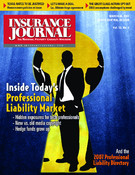The Texas Department of Insurance said on Mar. 9, 2007, it will require homeowner insurance carriers to file and justify their current rates in the coming months. The department said 2006 loss ratios, recent changes in the Texas market, and carriers’ decisions to exclude previously written risks prompted the move.
The combined ratio for the industry in 2006 was an estimated 64.8 percent; the loss ratio was 34 percent. In 2001 the in-dustry had a loss ratio of 116.9 percent and a combined ratio of 165.6 percent.
TDI said any rate review will be based on a multi-year period, taking into account severe weather/hurricane exposure and the need for companies to address adequate reserves for catastrophes.
If a carrier is found to be charging excessive rates, TDI will require the company to reduce its rates. Because risk exposure and policy forms are different, the rates will not be uniform for all carriers.
“Our duty under statute is to ensure that rates are reasonable and adequate,” said Jerry Hagins, insurance department spokesperson, in TDI’s announcement. “Even when you take into account Texas tornado, hail and hurricane exposure, companies should make sure that their rates are both competitive and affordable. If they’re not, then we have the tools to deal with it.” He cited a recent state district court decision to uphold a rate reduction order that had been challenged by Allstate.
Other factors that may affect rates and subsequent TDI actions include pending enforcement actions, rate changes that companies may already have made in 2006, and legislation affecting the Texas Wind-storm Insur-ance Associ-ation (TWIA) or other aspects of the Texas
market, the department said.
Insurance industry trade groups were quick to respond. “2006 was not a typical year for the insurance industry,” stated Mark Hanna, spokesman for the Insurance Council of Texas. “We were fortunate that we did not have the violent wind and hailstorms that have been the historical cost drivers for homeowners insurance in Texas and other states that are prone to severe weather.”
Hanna said homeowners insurance in Texas has more often than not been a losing proposition or break even at best. He said a good year like 2006 allows the industry to be better prepared to pay the claims from future losses.
He said when insurers are profitable, “it allows them to grow their business and be more competitive in the marketplace. Insurance is a cyclical business and it is not very often that we have a good year, much less a notable one.”
Jerry Johns, president of Southwestern Insurance Infor-mation Service, explained that insurers currently file and justify their rates and being told to do so again is redundant.
“The 2005 Texas legislature enacted an insurance modernization law which allows insurers to file their rates and use them unless they are deemed excessive by the Texas Department of Insurance,” Johns said.
“Profits enable companies to make improvements in the way they serve their customers, invest in Texas communities and pay for multi-billion dollar catastrophic weather events,” he added.
Profitability should be viewed over multiple years not a single year. For many years insurers lost hundreds of millions of dollars in Texas, Johns said.
ICT’s Hanna also said that recent profitability has lead to lower rates. Specifically, he said that homeowners and auto rates have gone down statewide every quarter for the past 10 quarters since Jan. 1, 2004. For the past two and half years, the statewide average for homeowners insurance premiums has decreased 10.5
percent.
Homeowners Insurance Loss and Combined Ratios: 2001 – 2006
Year Direct Written Premium Loss Ratio Combined Ratio
2001 $3,313,133,200 116.9% 165.6%
2002 $4,299,310,186 108.4% 158.0%
2003 $4,398,061,531 58.7% 96.3%
2004 $4,427,551,395 27.7% 58.7%
2005 $4,620,419,479 57.1% 88.2%
2006* $4,777,507,769 34.0% 64.8%*
*2006 expenses are estimated based on 2005 results.
Loss ratio reflects losses incurred on claims as a percentage of total earned premium.
Combined ratio includes the loss ratio and company expenses such as agent commissions, overhead, other administrative costs, and loss adjustment expenses.
Source: Texas Department of Insurance
Topics Carriers Texas Profit Loss Homeowners
Was this article valuable?
Here are more articles you may enjoy.


 Florida Heads for Smallest Orange Crop in Nearly a Century
Florida Heads for Smallest Orange Crop in Nearly a Century  DoorDash, Uber Cost Drivers $550 Million in Tips, NYC Says
DoorDash, Uber Cost Drivers $550 Million in Tips, NYC Says  AI Is the Biggest Mover on Allianz Risk Barometer; Cyber Takes Top Spot for Fifth Year
AI Is the Biggest Mover on Allianz Risk Barometer; Cyber Takes Top Spot for Fifth Year  10 Highest Class-Action Settlements in 2025 Eclipsed $70B Total: Duane Morris
10 Highest Class-Action Settlements in 2025 Eclipsed $70B Total: Duane Morris 


